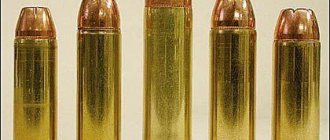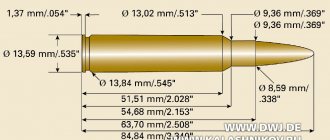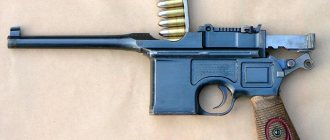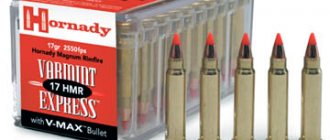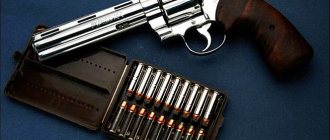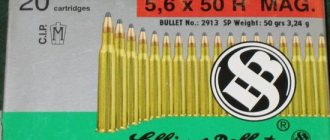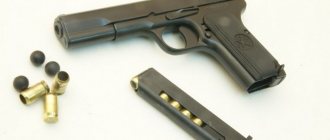A wide range of various weapons products are available to the attention of hunting enthusiasts on the shelves of specialized stores. Judging by numerous consumer reviews, Winchester 243 cartridges are especially popular.
Created specifically for shooting rodents, this ammunition is today effectively used for hunting medium-sized game. For some time it was also used as a sniper projectile by police special forces. The description and technical characteristics of the cartridge are presented in the article.
About the history of the creation of ammunition
The cartridge was developed in 1955 by the American weapons manufacturer Winchester Repeating Arms Company. The 6 x 51 mm ammunition is listed as 243 Win. Caliber - 6.2 mm. Since it was intended for branded carbines of models 70 and 88, used in varminting (high-precision shooting and sport hunting at long distances), American developers made fairly high demands on the cartridge. The 243 Win caliber was supposed to have ultra-high bullet speed, a flat trajectory and reduced recoil.
Positive factors
High flight speed and minimal recoil allowed the cartridge to become popular among hunters not only in America; the fame of shooting accuracy spread throughout the world.
The advantages of a product intended for small arms include:
- Initial speed level.
- Power.
- Compliance of technical data with the requirements provided for it.
- Hunting in open spaces for medium-sized animals at long distances.
- Little return.
- Good ballistic performance.
- Providing a flat trajectory.
- Sports target shooting at medium distance.
- Possibility of use in different types of weapons.
- A slight deviation from the target.
Please note that more than 20 types of 243 Win have been produced for hunting:
- Tunicales.
- Semishell.
- Expansive with partial emptiness.
For paramilitary units, jacketed bullets with lead or steel cores were released.
Application
The 243 Win cartridge of 6.2 mm caliber was originally created for shooting from long and ultra-long distances at rodents (rats, steppe squirrels) and small predators. As carbine owners used this ammunition, it was noted that it is universal and quite suitable for hunting large ungulates. Judging by numerous reviews from shooters, using the 243 Win caliber, you can kill a gilt, a roe deer or a small deer. American hunters use this ammunition to hunt: white-tailed deer, wild boar, peccary, ungulates living in the mountains (mouflon, chamois), and other medium-sized game. This cartridge fully meets all the requirements for it and is in great demand among hunters in both the United States and other countries. It is the most popular deer hunting cartridge on the UK gun market. At the same time, in England, Winchester 243 is considered the minimum permitted caliber for hunting this animal. In Russia, an American-made cartridge is used when hunting small wild boar, fox and roe deer. The Winchester 243 is also in demand among African shooters. With its help, small antelopes are caught: springboks and impalas. The open spaces of the savannah have become the ideal place where all the advantages of the Winchester 243 are fully demonstrated.
Varminting is very popular among lovers of rifled firearms. This entertaining and sporting shooting from long and ultra-long distances is carried out using special types of rifled weapons and ammunition with their inherent flat and flat trajectory. One of these cartridges was the 308 Win. The low recoil during shooting and the low cost of this ammunition explain its great demand among varmint enthusiasts. The Winchester 243 is not in demand in the army. However, for some time this cartridge was in service with the Los Angeles police special forces.
The .243 Win cartridge appeared in 1955 and is a direct descendant of the famous standard NATO rifle cartridge 7.62x51 (.308 Win). The cartridge was obtained by compressing the barrel of the original 7.62 mm cartridge to 6 mm. Hence the almost identical sizes of the cartridge cases of these two cartridges, which allows the same magazines and bolts to be used in weapons with interchangeable barrels.
The cartridge owed its success to the Winchester 70 rifle, which conquered the market for this cartridge. The Ammo & ballistics cartridge guide considers the .243 Win cartridge to be the second most common caliber in the world, after the .30-06 Sprg, taking into account the number of rifle models for it.
The cartridge has several alternative markings - 6x51 Winchester, 6.16x51, 6 mm Winchester. The maximum bullet diameter is 6.18 mm, weight ranges from 4 to 6.5 g.
The main feature of the cartridge is the flat trajectory of the bullet at distances of up to 300-400 m, which is achieved by a very high initial bullet speed. It can reach 1097 m/s with light bullets. The average initial speed of heavy (6.2 g) bullets is within 900 m/s.
As an example, let's compare .243 Win and .308 Win cartridges produced by Norma.
.243Win and .308Win cartridges
In both cases we take fully jacketed bullets (FMJ).
Cartridge .243 Win 6.2 g/95 grains, ballistic coefficient 0.351, muzzle velocity 900 m/s, muzzle energy 2496 J.
Cartridge .308 Win 9.7 g/150 grains, ballistic coefficient 0.423, muzzle velocity 810 m/s, muzzle energy 3183 J.
Table 1. Velocity of .243 Win and .308 Win bullets at distances
| V/distance | 0 | 100 | 200 | 300 |
| .243Win | 900 | 784 | 678 | 580 |
| .308 Win | 810 | 741 | 675 | 613 |
The downside of the high initial velocity of the bullet in combination with its small caliber is the reduced barrel survivability compared to medium-caliber rifles. It is believed that the larger the caliber and the lower the initial velocity of the bullet, the less the rifling “burns out.” It is no coincidence that Glock guarantees its 9 mm pistols for 60 thousand shots. As for the .243 Win caliber, the service life of a rifle for it before accuracy decreases can be 1500 or a little more shots.
The reduction to 200 m is insignificant (only 12 cm when zeroing in at 100 m), which makes it possible not to introduce vertical corrections at such a distance with a damage zone of 25 cm. In other words, the direct shot distance for a circle of 25 cm will be maximum 200 m.
Table 2. Absolute reduction of .243 Win and .308 Win in mm when zeroing at 100 m
| 50 | 100 | 150 | 200 | 300 | |
| .243Win | -3 | 0 | -37 | -121 | -457 |
| .308 Win | 0 | 0 | -45 | -139 | -494 |
After this distance, it is already advisable to introduce vertical corrections, since by 300 m the decrease is already 45 cm.
The energy of the .243 Win cartridge is approximately 25% lower than that of the .308 Win.
Table 3. Energy of .243 Win and .308 Win bullets at distances
| E/distance | 0 | 100 | 200 | 300 |
| .243Win | 2496 | 1895 | 1415 | 1035 |
| .308 Win | 3183 | 2664 | 2212 | 1823 |
However, the energy of the cartridge is quite sufficient at distances of up to 200 m for hunting medium-sized ungulates. There is a well-known formula that suggests that the energy of a bullet at the distance corresponding to hitting the target is considered sufficient for the weight of the animal x10. That is, to defeat, for example, a wild boar weighing 150 kg (x10), a bullet energy of 1500 J will be sufficient at the moment it hits the target.
From table No. 3 it follows that, in accordance with this formula, hunting 150 kg of wild boar with the .243 Win cartridge is possible at a distance of up to 200 m.
An additional damaging factor for the bullet of the cartridge in question is a temporary pulsating cavity. Since the tissues of an animal consist of 90% water, when a bullet hits them at speeds above sound (370 m/s), shock waves spread to the sides of the wound channel, similar to circles diverging from a stone thrown into water. At the same time, the number of such oscillations can reach several thousand per second. These vibrations cause damage to internal organs and cause shock. The internal pulsating cavity achieves its greatest effect when hit by a bullet at a speed of about 2x the speed of sound (or 700 m/s). From Table 1 it can be seen that the .243 Win bullet maintains this speed up to approximately 200 m.
I will also bring up an alternative point of view, which is typical for Russia, that only rifle calibers of 7.62 mm and higher are suitable for hunting ungulates. In some cases, hunting with smaller caliber weapons is even prohibited on hunting grounds.
I can agree with this point of view only to the extent that you need to weigh the capabilities of your weapons and ammunition with the size of the game and the distance to it.
https://youtu.be/2jF3_DpJkrw
My personal opinion is that the .243 Win caliber cartridge with bullets of special hunting equipment (half-jacket, expansive) can be successfully used at distances of up to 200 m for hunting medium-sized ungulates.
This cartridge is one of the most popular for target shooting at long distances, as well as for varminting - sport hunting for agricultural pests (marmots, prairie dogs).
The recoil of the cartridge is at the level of the domestic 7.62x39 mm, and 30-40% lower than that of 7.62x51 (.308 Win). I will note that the recoil is also quite sharp compared to the same 7.62x39 mm.
The cartridge is little used in the armies of the world, but it is quite popular in the police and anti-terrorist units. This is due to the specifics of the work of police and special structures that operate mainly in cities. Distances rarely exceed 200-300 m, and it is in this range that the positive ballistic properties of the .243 Win are most clearly revealed - flat trajectory, high speed and strong shock effect.
Let's talk about the availability of the cartridge in Russia. The most common cartridges now produced by European companies are Norma, Sellier&Bellot, RWS/Geco. Unfortunately, prices are very high - for example, one Swedish Norma cartridge with Oryx bullets or a regular half-shell can cost 300-380 rubles. German cartridges are also at this level. Czech cartridges are somewhat cheaper. American cartridges completely disappeared from the range after the introduction of sanctions. A cheap alternative that appeared several years ago in the form of Barnaul cartridges of the “Centaur” series, which used American Hornady bullets, is gradually disappearing from the shelves of gun stores for the same reasons.
Personally, my experience suggests that the best factory cartridges currently available on the market in terms of shooting accuracy are those from the Swedish company Norma and the Finnish company Sako.
Conclusions on the cartridge.
First of all, the .243 Win cartridge can be recommended for fans of high-precision shooting at distances up to 500 m, as well as for hunters for use at distances up to 200 m against medium ungulates. The ballistics of the cartridge allows you to make a “direct shot” at significant distances.
The cartridge is completely unsuitable for the so-called. "recreational shooting", since the barrel life of the weapon that uses it is limited, and the cost of ammunition is very high for training with a high consumption of ammunition.
“Hydrodynamic shock” from a bullet, or what Yandex was “scared” of
Practicality in Finnish style: Tikka T3 Super Varmint.
https://youtu.be/2jF3_DpJkrw
https://youtu.be/2jF3_DpJkrw
About the technical characteristics of the cartridge
Ammunition data:
- The product belongs to the type of rifle hunting cartridges.
- Country of origin: USA.
- Manufacturer: Winchester Repeating Arms Company.
- The cartridge was created in 1995. Currently in production.
- The sleeve length is 51.9 mm.
- The length of the cartridge is 68.63 mm.
- Caliber 6.2 mm.
- The bullet weighs 3.6 g.
- The diameter of the sleeve neck is 7 mm, the base is 12 mm, the flange is 11.95 mm.
- The bullet has an initial speed of 1237 m/s.
- The initial bullet energy is 2728 J.
Recommendations from experienced hunters
An experienced hunter will never use a bullet that is not suitable for its intended purpose. It's like going with a pitchfork at a lynx or a lion, wondering whether or not you'll be lucky enough to hit the vital arteries when it drops dead instead of in a terrible rage. All the rules for hunters, passing exams for a hunting license, were created on the “blood” of sad experience.
Animals of average weight are divided into groups:
- Up to 80 kg . — these include saigas, foxes, and wolves.
- Up to 150 kg . - These are small spotted deer, mountain goats, wild boars, small moose and reindeer.
All animals over 200 kg are classified as large game . If the ammunition is not intended for this purpose, it is impossible to load guns with it, since the shooter will not be able to kill the animal, but only wound it. Many animals have a high tolerance for wounds and may instinctively launch a lethal attack.
Particular consideration should be given to mountain game . They rarely have a large mass, where the flatness of the cartridges is important. The 243 Win belongs to the mountain caliber . With such weapons it is good to hunt chamois, ram or goat that live on the tops and ridges of cliffs. In this case, regardless of the distance, the target will be hit, provided that the direction and strength of the wind are provided.
You should not fall into the common misconception of trying to select a caliber from our cartridges according to the characteristics of a Western manufacturer. Russian factories do not produce analogues; they can only be close to Winchester, but with worse quality.
Some recommendations for using the cartridge
Judging by the reviews of experienced hunters, a shooter using this ammunition must be very careful. You need to be especially careful when shooting at close range. This recommendation is due to the fact that powerful cavitation occurs as a result of a bullet impact. This entails breaking the carcass.
Some consumers are interested in whether it is possible to hunt bear with this cartridge. Experienced shooters argue that this is not worth doing, since with the high speed of the bullet and due to its large weight, the power of the projectile will not be enough to “cleanly” hit such a large animal. According to experts, using the Winchester 243 while hunting a bear puts the shooter at great risk.
This caliber is recommended for its intended use. Animals whose weight does not exceed 150 kg are considered objects for hunting. The optimal distance for shooting at large ungulates is 200 meters.
What are the disadvantages of the cartridge properties?
There are restrictions on caliber 243 in some countries:
- In the United States, they hunt any medium game that is included in the hunting legislation. Where freedom of action is a national tradition. Control over order is the prerogative of state bodies.
- In England, the cartridge is very popular for shooting deer and is the minimum allowed for this type of animal.
- Russian hunters freely use small wild boars and roe deer.
- In African savannas it is legal to shoot antelope.
- Germany banned the use of this caliber.
In any state, a hunter must exercise extreme caution . Do not take risks when hunting large animals.
Such restrictions are necessary to regulate distances. If the distance is small, powerful cavitation is created from physical processes. The carcass of the beast, the formed forces will simply tear it apart. It is not recommended to go after a bear with such weapons. Everything matches there - the speed and weight of the bullet, but there is no power to immediately hit the beast. Perhaps he will be killed, but he will have time to attack the shooter. Therefore, you need to count on the reliability, striking and stopping properties of ammunition. Game must be no more than 201 kg and at a distance of 251 m .
